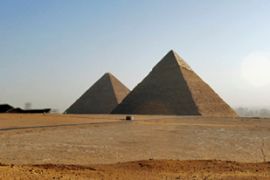Great Pyramid built ‘inside out’
French architect uses 3D technology to trace a pyramid within a pyramid.

| External link |
To prove his case, Houdin teamed up with a French company that builds 3D models for auto and airplane design, Dassault Systemes, which put 14 engineers for 2 years on the project.
Now, an international team is being assembled to probe the pyramid using radars and heat detecting cameras supplied by a French defence firm, as long as Egyptian authorities agree.
Bob Brier, a senior research fellow from Long Island University attending the unveiling, said: “This goes against both main existing theories. I’ve been teaching them myself for 20 years but deep down I know they’re wrong.
“Houdin’s vision is credible, but right now this is just a theory. Everybody thinks it has got to be taken seriously.”
‘Durable development’
Egypt‘s Supreme Council of Antiquities was not immediately available for comment. Dassault said Brier and other Egyptologists attending the ceremony were supporters of Houdin’s theory but had no financial links to him or the firm.
Houdin began working full-time on the riddle eight years ago after a flash of intuition passed to him by his father, an engineer, and five years before actually visiting the site.
He found that a frontal, mile-long ramp would have used up as much stone as the pyramid, while being too steep near the top. He believes an external ramp was used only to supply the base.
 |
| Houdin began working full-time on the puzzle of the pyramids eight years ago [AP] |
An external corkscrew ramp would have blocked the sight lines needed to build an accurate pyramid and been difficult to fix to the surface, while leaving little room to work.
Houdin said: “What characterised the Egyptians was their sense of perfection and economy.
“We talk of durable development now, but it was the Egyptians who invented it. They didn’t waste a single stone. They relied purely on intelligence.”
Houdin also claimed to have shed light on a second enigma surrounding the purpose of a Grand Gallery inside the pyramid.
The Frenchman believes its tall, narrow shape suggests it accommodated a giant counter-weight to help haul five 60-tonne granite beams to their position above the King’s Chamber.
Al Jazeera is not responsible for the content of external websites